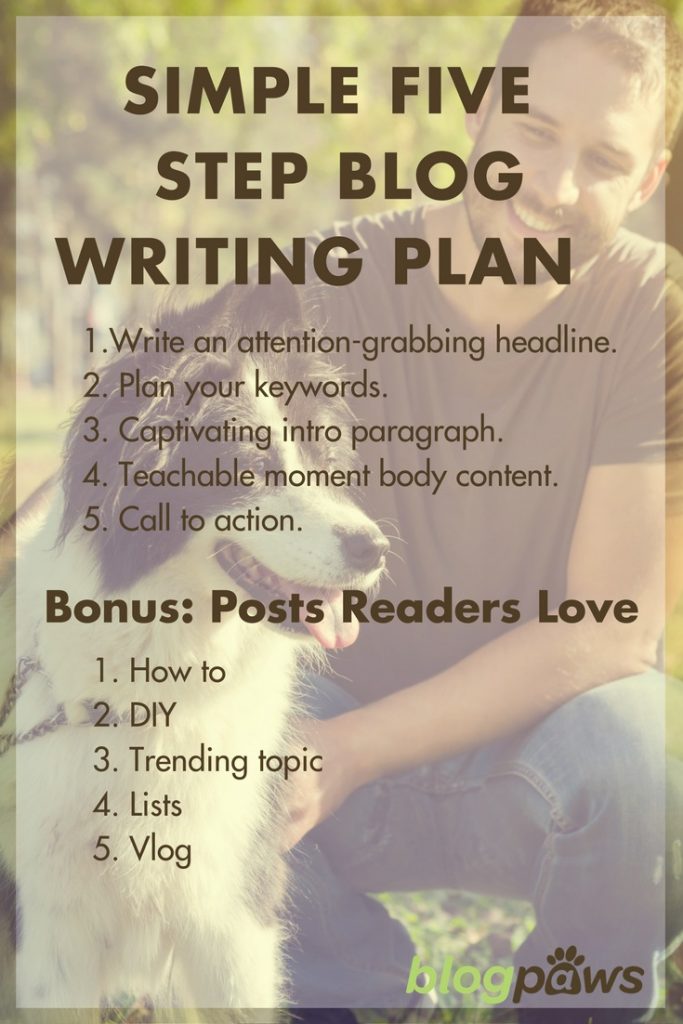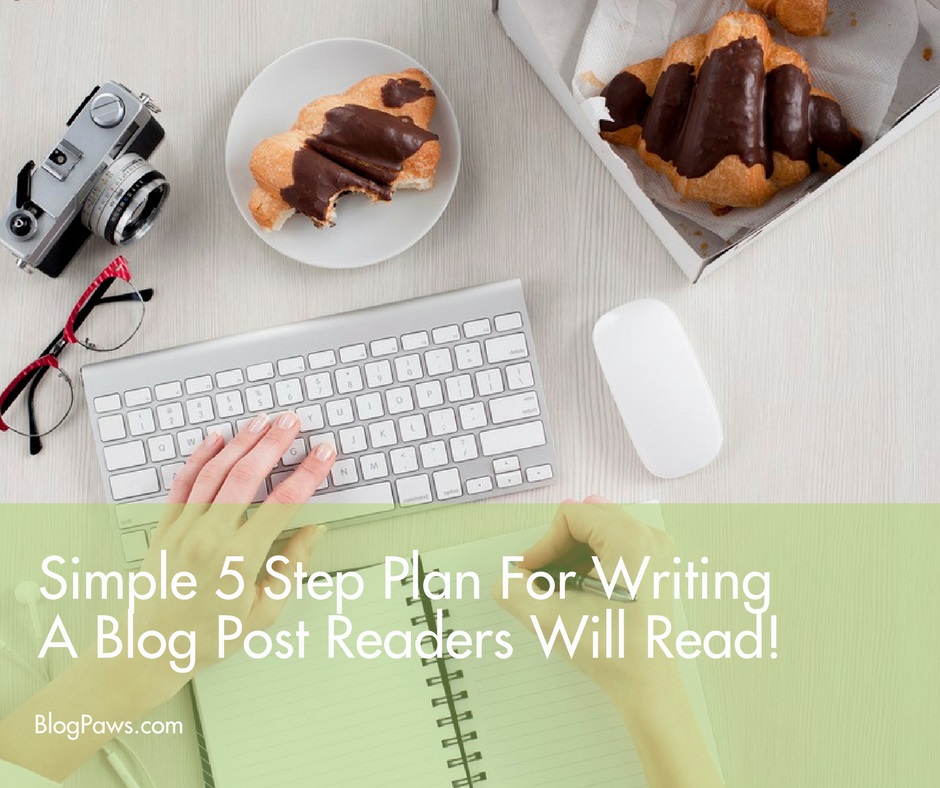Simple 5-Step Plan for Writing a Killer Blog Post
If blogging were simple everyone would do it, right? As someone who has written more than two million words in her writing career, I can tell you that if you have a system in place, you can take the stress out of virtually any task. Whether you’re writing a novel or a blog post, there are steps that are universal, and once you wrap your mind around that, your blogging tasks will move along so much more smoothly… I can virtually guarantee it!
If you find these steps don’t work, track me down at BlogPaws 2017, and I’ll buy you a coffee while we discuss any problems you’re having with your blogging tasks.
Simple 5-Step Plan for Writing a Killer Blog Post
Here are the elements that go into a killer blog post:
- Attention-getting headline
- Keywords
- Captivating introductory paragraph
- “Teachable moment” body content
- Call to action
Simple, right? Now, let’s delve a bit deeper into each of the elements.
Attention-getting headline
You may have stellar content, but if your headline doesn’t lure the reader in, how will they know? Your headline should be:
- Readable
- Searchable
- Exciting enough to give someone the reason to come and read your post
Consider this: 5 Ways To Write A Blog Post. It’s readable and searchable but not very exciting. Readable and searchable are great, though don’t get me wrong.
How about this: Simple 5-Step Plan For Writing A Killer Blog Post. It’s readable, searchable and is a bit more exciting. Why? The words “simple” and “5-step plan” amp up the excitement factor while still letting the reader know what they will find if they click, AND it’s searchable from various terms. Win-win, right?
How can you get a great headline? There are headline generators. You can look at your Google Analytics and see what terms people are using to find your site and add those words into your headline. Do a Google search on a topic about which you want to write and see how many posts show up in that category. Or check out our tips: How to Write Click-Worthy Headlines and 21 Headline Formulas That Work. 
Keywords
Never keyword stuff. Google doesn’t like it and neither do your readers. For this post, for example, I have sprinkled the words “simple 5 step plan” and “writing a blog post” and “writing” and “blog post” into the text in a way that allows the text to flow naturally while amping up the searchability of the post with Google.
I suggest you work from an editorial calendar and when you put that calendar together, make note of the keywords for which you want to be found. Maybe every month of the year you want to be found for “writing” and “blog post” but maybe you want to be found for “writing blog posts for cat parents” or “best groomer in the upstate New York area” or even holiday keywords.
Having your potential keywords for each month/week/quarter listed on your editorial calendar will keep you on track and will also keep your content focused. If, for example, I simply wrote “best dog groomer” without any qualifier it would be hard for me to be found in a search (if I were a dog groomer!) because it’s too vague. “Writing” or “blog post” could be further narrowed to a niche of “freelance writing” or “pet writing” or “blog post plan” or “blog post writing for cat owners.”
Captivating introductory paragraph
Fiction authors call the opening sentence the “hook.” When writing nonfiction you have a bit more time to “hook” the reader so make certain your introductory paragraph is captivating. “Tease” the reader with the promise of what’s to come in the following paragraphs. Let them know whether there will be “take aways” they will be able to incorporate into their lives once they’ve completed the post.
Your introductory paragraph lets the reader know whether he or she will be perusing a scholarly white paper, a fun and light-hearted DIY piece, or a blog that falls somewhere in between the two. It is your tone and your unique voice that will keep a reader with you. Every blogger has a unique tone, and that is what will set your blog apart from the competition even if you’re all blogging on the same topic.
Teachable moment body content
Even when I write a blog post about my battle with breast cancer, I add in what I consider a “teachable moment.” Sure, there may be some readers who will read about breast cancer just to empathize with what I went through. However, when I write about breast cancer I have a focus of “gratitude” or “what I learned and how I now live my life and you can, too” or “journaling through hardship” or “time management tips I learned while going through it.” Who can’t use a bit more time management and productivity in their lives?
If you’re writing “memoir-type” blog posts and don’t have a take-away for the reader other than taking them along with you in spirit on your journey, that is fine; just let the reader know up front.
I want every post I write to have a take-away that the reader can feel, “Hey, I can do that!” You don’t have to have had a life-threatening illness to have a take-away of something you can incorporate into your lifestyle.
Call to action
Don’t let the reader leave your website and your blog post without first taking an action. What is that action?
- Sign up for our newsletter
- Attend my free webinar
- Join me on a Facebook live this week
- Grab my “Top 10 Tips on XYZ”
- Schedule your complimentary call with me
No matter what your call to action or offer is, make note of that at the end of your blog post. Your call to action could be: Hey, leave me a comment below to let me know what areas you struggle with when writing your blog posts. (See what I did there?!)
BONUS! Here are five types of blog posts readers love:
- How-tos. If you’re a DIY-er and love to teach, this post type needs to be one of your go-tos.
- Curated posts. Share the love by curating and sharing the posts of bloggers whom you admire in a curated post.
- Trending topic. Is there something big going on in the pet industry? Jump on that topic and write your blog post based on what’s in the news.
- A list post. 50 ways to make your dog happy; 10 tips for entertaining your cat on a road trip; six ways to help your reptiles survive a power outage (I learned those during a recent power/heat outage here in upstate New York).
- Vlog. Jump in front of your camera, take a blog post you’ve already written and turn it into a vlog (video blog). If you can repurpose content it’s a win-win for you and your readers!
Robbi Hess is an award-winning author, full-time writer, newspaper columnist, writing coach and time-management guru. She works with bloggers and solopreneurs and blogs at All Words Matter. I will be speaking at BlogPaws 2017 as part of the Cat Writers’ Association. My topic is: “Overworked & Overwhelmed? The Four-Step Process for Reinventing Your Writing” Synopsis: Whether you’re writing full time, blogging, in the midst of a multi-book project or just starting out, this session will help you lose the feeling of being overworked and overwhelmed. You’ll learn a four-step process to beat procrastination, use time blocking to help you get more done, claim your writing time and bump up your creativity and some in-the-trenches writing tips, hacks and advice. There will be giveaways, handouts and time for questions! Hope to see you there!

